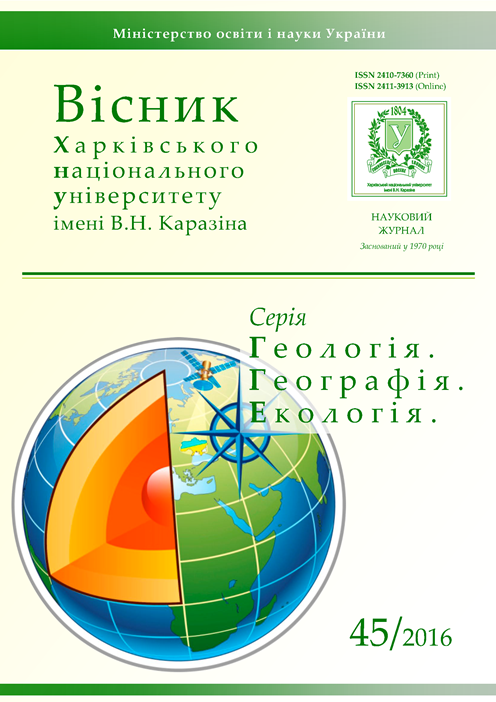Spatial distribution of climatic indexes on the territory of forest-steppe and steppe of the left-bank Ukraine
Abstract
The features of average monthly air temperature distribution, monthly rainfall and the ground atmospheric pressure on the left-bank Ukraine during a year have been examined in the article. With the help of cluster analysis regularities of spatial changes in basic climatic indexes during a year for the period from 1951 to 2000 have been determined. North Atlantic influence on climatic characteristics of the studied territory has also been investigated. By means of statistical analysis the changes in temperature condition are specified on the territory of Kharkiv region for the period from 2001 to 2014. By means of cluster and component analyses climatic fields of average monthly air temperature values, monthly rainfalls and atmospheric pressure have been studied at 38 stations for the year in the second half of the last century. The cluster analysis is an heuristic algorithm based on the Euclidean distances determined with predetermined threshold values. Further study of the climate of Ukraine, as a component of the global climate, will identify features and rate of change of meteorological parameters. Cluster analysis characterizes the same type of districts on temperature conditions, moisture regime and atmospheric pressure within the limits of forest-steppe and steppe of the left-bank Ukraine. In autumn there is leveling of the climatic field of atmospheric pressure: northern district embraces almost all the territory of forest-steppe and steppe, displacing the southern to the coast of the Azov sea. Within the limits of Luhansk and Donetsk regions the south-eastern district recommences. Analysis of the average monthly values of air temperature on the presented territory have shown two main districts in an autumn-winter period: northern and southern, the border between them passes on the line of the north-west of Luhansk region, the north of Donetsk and the south of Dnipropetrovsk regions. It takes place near the barometric axis of Voyeikow, which is defined by atmospheric circulation. In a spring-summer period when the main value has the feature of laying surface, in forest-steppe and steppe of the left-bank Ukraine a local district is formed on the territory of the Azov-Donetsk ridge.
Downloads
References
2. Balabux, V. O., Maly’cz’ka, L. V., Lavry’nenko, O. M. (2015). Osobly’vocti poqodny’x umov 2014 r. v Ukrayini [Features of weather in Ukraine in 2014]. Scientific papers of Ukrainian SRHMI, 267, 28-38.
3. Ivanov, S. V., Dranicher, O. R. (2013). Jeffekt al'bedo k gorodskomu teplovomu ostrovnomu formirovaniju [The albedo effect to the urban heat island formation]. Vesnik ODEKU, 15, 79-88.
4. Izrajel' Ju. A., Nazarov, I. M. (2004). Problema opasnogo antropogennogo vozdejstvija na klimaticheskuju sistemu zemli [Problem of dangerous anthropogenous impact on climatic system of the earth]. Meteorologija i gidrologija, 11, 5-16.
5. Goncharova L. D., Shkol'nij, E. P. (2007). Metodi obrobki ta analіzu gіdrometeorologіchnoy іnformacіy (zbіrnik zadach і vprav): navchal'nij posіbnik [Methods of processing and analysis of hydrometeorological information]. Odesa, Ekologіja, 464.
6. Grushevs’ky’j, O. M. (2012). Pro deyaki fizy’chni mexanizmy’ evolyuciyi blokuyuchogo anty’cy’klonu v period for-muvannya anomal’ny’x pogodny’x umov vlitku 2010 roku [On some physical mechanisms of evolution of the blocking anticyclone during the formation of the anomalous weather conditions in the summer of 2010]. Ukrainian Hydrometeorological Journal, 10, 41-49.
7. Loginov, V. F. (2008). Global'nye i regional'nye izmenenija klimata: prichiny i sledstvija [Global and regional climate change: causes and conseguences]. Minsk, TetraSistema, 496.
8. Loginov, V. F. (2011). Global'nye i regional'nye izmenenija klimata i ih dokazatel'naja baza [Global and regional climate change and its evidence base]. Doklad na Mezhd. nauch. konf. "Global'nye i regional'nye izmenenija", 16-19 nojabrja, 2010 g., Kiev, Nika-Centr, 23-37.
9. Loginov, V.F. (2012). Radiacionnye faktory i dokazatel'naja baza sovremennyh izmenenij klimata [Radiations factors and evidence of modern climate change]. Minsk, 266.
10. Climate Change 2013 (2013). The Physical Science Basis. Summery for Policymakers. Geneva, 28. Aviable at: http://www.ipcc.ch/report/ar5/wg1/
11. Mailier, P. J., Stephenson, D. B., Ferro, C. A. and Hodges K. I. (2006). Serial clustering of extratropical cyclones. Nature, 134, 8, 2224–2240.
12. Оrsolini, Y. J., Doblas-Reyes, F. J. (2003). Ozone signatures of climate patterns over the Euro-Atlantic sector in the spring. Q. J. R. Meteorol. Soc., 129, 3251–3263.
13. Roemmich, D., John Gould, W., Gilson, John (2012). 135 years of global ocean warming between the Challenger expedition and the Argo Programme. Nature Climate Change. DOI 10.1038/nclimate 1461.
14. Shvidenko, A. (2009). Non-boreal Forests of Eastern Europe in a Changing World: the Role in the Earth Systems. Regional Aspects of Interactions in Non–boreal Eastern Europe, 123-133.
15. Shevchenko, O., Snizhko, S., Samchuk, E. (2011). Temperaturni anomaliyi velikogo mista [Anomalies in the big city]. Ukrainian Hydrometeorological Journal, 8, 67-73.
16. Pol'ovyy, A. M., Bozhko, L. E., Dronova, E. A., Barsukova, O. A. (2012). Vplyv zmin klimatu na dynamiku voloho-zabezpechenosti v Ukrayini [Climate changes impact on the dynamics of moistening indexes in Ukraine]. Ukr. Gidrometeorol. J., 12, 95-105.
17. Tollefson, J. (2014). The case of the missing heat. Nature, 505, 276-278.
18. Yermolenko, N. S., Khokhlov, V. N. (2012). Sravnenie prostranstvenno-vremennyh osobennostej zasuhi v Ukraine v nachale i konce XX veka [Comparison of spatio-temporal features of droughts in Ukraine beginning and the end of the twentieth century]. Ukrainian Hydrometeorological Journal, 10, 65-71.
19. Serga, Je. N. (2003). Universal'nyj adaptivnyj iteracionnyj metod klasternogo analiza [The universal adaptive iterative method of the cluster analysis]. Meteorologіja, klіmatologіja ta gіdrologіja: Mіzhvіd. nauk. zb. Ukrayni, 47,
83-89.
20. Snizhko S. I. Theory and methods of analysis of regional hydrochemical systems. К., Nika–Center, 2006, 284.
21. Zatula, V. I., Zatula, D. V. (2011). Zastosuvannya interpolyatsiynih polinomiv Nyutona dlya obchislennya serednih dat perehodu temperaturi povitrya cherez pevni rivni v Ukrayini [Newton interpolation polynomials application for calculation of average dates of air temperature transition through determined levels in Ukraine]. Ukr. Gidrometeorol. J., 8, 60-66.





